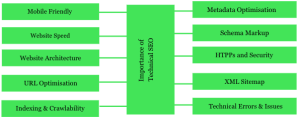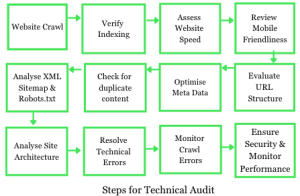How to Conduct a Technical SEO Audit?
A technical SEO audit is a comprehensive evaluation of the technical elements of a website to identify areas that can be optimized for better search engine visibility and performance.
It involves assessing website architecture, page speed, indexing status, crawl ability, URL structure, metadata, mobile-friendliness, and other technical aspects that impact how search engines crawl, index, and rank a website.
A technical SEO audit aims to uncover any issues or errors that may hinder search engine optimization efforts and provide actionable recommendations to enhance the website’s technical foundation and improve its organic search rankings.
Read further to know how you can execute technical SEO to improve the visibility of your website.
What is Technical SEO Audit?
Technical SEO audit refers to the optimization of the technical aspects of a website to improve its visibility and performance in search engine rankings.
- It involves implementing best practices and techniques that enable search engines to crawl, index, and understand the website’s content effectively.
- Technical SEO is about optimized website speed, site architecture, mobile-friendliness, URL structure, indexing, crawlability, metadata, schema markup, XML sitemaps, and more.
By ensuring that the technical foundation of a website is strong, technical SEO helps search engines better understand and rank the website’s pages, leading to improved organic search visibility, user experience, and, ultimately, increased organic traffic.
Importance of Technical SEO
Technical SEO refers to optimizing a website’s technical aspects to improve its visibility and performance in search engine rankings. It involves implementing various techniques and strategies to ensure search engines can easily crawl, index, and understand the website’s content.

Here are some key components and practices of technical SEO:

Website Speed:
Optimizing the website’s loading speed is crucial for search engine rankings and user experience. This involves minimizing file sizes, leveraging browser caching, optimizing code, and using content delivery networks (CDNs) to improve page load times.
Mobile-Friendliness:
With most searches happening on mobile devices, having a mobile-friendly website is essential. It involves implementing responsive design, ensuring proper viewport configuration, and optimizing the website’s layout and content for mobile devices.
Website Architecture:
A well-structured website architecture helps search engines understand the hierarchy and organization of the website’s content. This includes logical navigation menus, a clear URL structure, and appropriate internal linking to facilitate easy crawling and indexing.
URL Optimization:
Optimizing URLs involves using descriptive and keyword-rich URLs that accurately represent the content of each page. This makes it easier for search engines and users to understand the page’s context.
Indexing and Crawlability:
Ensuring search engines can crawl and index the website’s pages is vital for visibility. This includes creating and submitting an XML sitemap, using robots.txt files to control crawler access, and fixing any crawl errors or issues that may hinder indexing.
Metadata Optimization:
Optimizing meta tags, such as title tags and meta descriptions, is crucial for improving click-through rates in search engine results. Relevant and compelling metadata helps search engines, and users understand the content and relevance of each page.
Schema Markup:
Implementing structured data markup, such as Schema.org, helps search engines understand the context and meaning of the website’s content. This can lead to rich snippets and enhanced search results, increasing visibility and click-through rates.
HTTPS and Security:
Implementing a secure website using HTTPS (Hypertext Transfer Protocol Secure) is essential for user privacy and trust. It also serves as a ranking signal for search engines.
XML Sitemaps:
Creating and submitting an XML sitemap helps search engines discover and index all the important pages on the website. It provides a roadmap for search engines to crawl and understand the website’s structure.
Technical Errors and Issues:
Conducting regular audits to identify and fix technical errors is crucial. This includes fixing broken links, resolving duplicate content issues, eliminating 404 error pages, and addressing server or hosting issues.
How to Conduct a Technical SEO Audit?
To conduct a technical SEO audit and ensure that your website is optimised for search engines, follow these steps:

Image: Steps to Conduct Technical Audit
Here is a quick SEO audit checklist for you to refer:
Perform a Website Crawl
Use a crawling tool like Screaming Frog or DeepCrawl to analyze your website’s structure, URLs, and metadata. This will provide a comprehensive overview of the technical elements of your site.
Verify Indexing
Check if your website’s pages are being indexed by search engines. Use the “site:” operator in search engines (e.g., site:yourwebsite.com) or tools like Google Search Console to ensure your pages are included in search results.
Assess Website Speed
Use tools like Google PageSpeed Insights or GTmetrix to evaluate your website’s loading speed. Optimise image sizes, server response time, caching, and minification to improve website performance.
Review Mobile Friendliness
Ensure that your website is mobile-friendly and provides a seamless user experience on mobile devices. Use Google’s Mobile-Friendly Test tool to identify issues and implement responsive design techniques.
Evaluate URL Structure
Review your website’s URLs for readability, keyword relevance, and consistency. Use descriptive and keyword-rich URLs that accurately represent the content and hierarchy of each page.
Optimise Metadata
Assess your title tags, meta descriptions, and header tags (H1, H2, etc.) for optimization. Ensure they are unique, and relevant, and include targeted keywords to improve search engine visibility.
Check for Duplicate Content
Identify and resolve duplicate content issues, as they can negatively impact rankings. Use tools like Copyscape or Siteliner to identify duplicate content across your website and take appropriate actions like canonicalisation or rewriting.
Analyse XML Sitemap and Robots.txt
Ensure your XML sitemap is properly structured, up-to-date, and submitted to search engines. Review the robots.txt file to confirm that it allows search engines to crawl essential sections of your site and restrict access to non-essential areas.
Analyse Site Architecture
Evaluate your website’s navigation, internal linking, and URL structure. Ensure they facilitate easy navigation for users and search engine crawlers. Create a logical hierarchy and fix any broken or orphaned pages.
Resolve Technical Errors
Identify and fix technical errors such as broken links, 404 error pages, redirect issues or server errors. Use tools like Google Search Console or third-party tools to promptly identify and address these issues.
Monitor Crawl Errors
Regularly monitor and fix crawl errors reported by search engine crawlers. Resolve issues like 404 errors, redirect chains, or excessive redirects that can hinder crawling and indexing.
Ensure Website Security
Implement security measures like SSL certificates and HTTPS usage to protect user data and gain search engine trust. Regularly check for potential security vulnerabilities and malware threats.
Implement Structured Data:
Utilize structured data markup (e.g., Schema.org) to provide additional context to search engines. This can lead to rich snippets and enhanced search results.
Monitor Website Performance
Monitor website performance using tools like Google Analytics and Google Search Console. Analyze metrics such as organic traffic, bounce rate, and conversions to identify areas for improvement.
Conclusion
A comprehensive SEO audit examines various aspects such as website structure, indexing status, page speed, mobile-friendliness, URL structure, metadata optimization, and more. It also includes resolving technical errors, implementing structured data, and monitoring website performance.
Remember that SEO is an ongoing process; regular audits are necessary to keep up with changing algorithms and industry best practices. By conducting regular audits, you can stay ahead of the competition, improve your website’s user experience, and boost its visibility in search engine results.
If you need professional assistance in conducting an SEO audit and developing an effective strategy for your business growth, Noboru can help. Contact us at hello[at]noboruworld.com to learn more about our technical SEO audit services.
FAQ
What is graphic design?
Graphic design is the art and practice of combining visuals, typography, and other elements to create visual representations that convey messages or communicate ideas effectively.
What are the key skills needed for graphic design?
Key skills for graphic design include creativity, knowledge of design principles, proficiency in design software, typography, color theory, and the ability to understand and communicate visual concepts.
What is the importance of graphic design in business?
Graphic design plays a crucial role in business as it helps build brand identity, create memorable visual experiences, communicate messages effectively, and engage target audiences, ultimately contributing to business success.
What is the difference between graphic design and web design?
Graphic design primarily focuses on creating visual elements for various mediums, including print, branding, and digital media. On the other hand, web design deals explicitly with designing and structuring websites and user interfaces for online platforms.
How much does graphic design cost?
The cost of graphic design varies depending on various factors, such as the project’s complexity, scope of work, experience of the designer, and geographical location. It’s best to discuss specific requirements with a designer or agency to get a customized quote.
Also Read – How to Do an SEO Audit in 11 Easy Steps (With Checklist)



